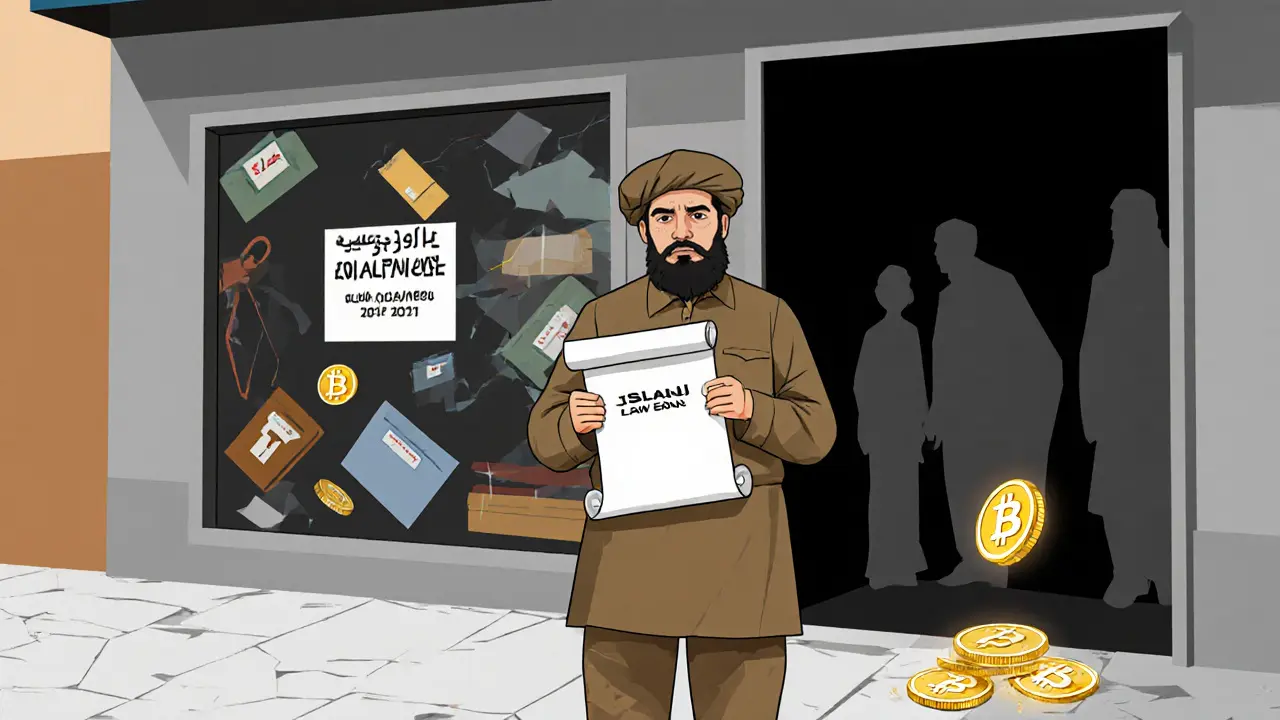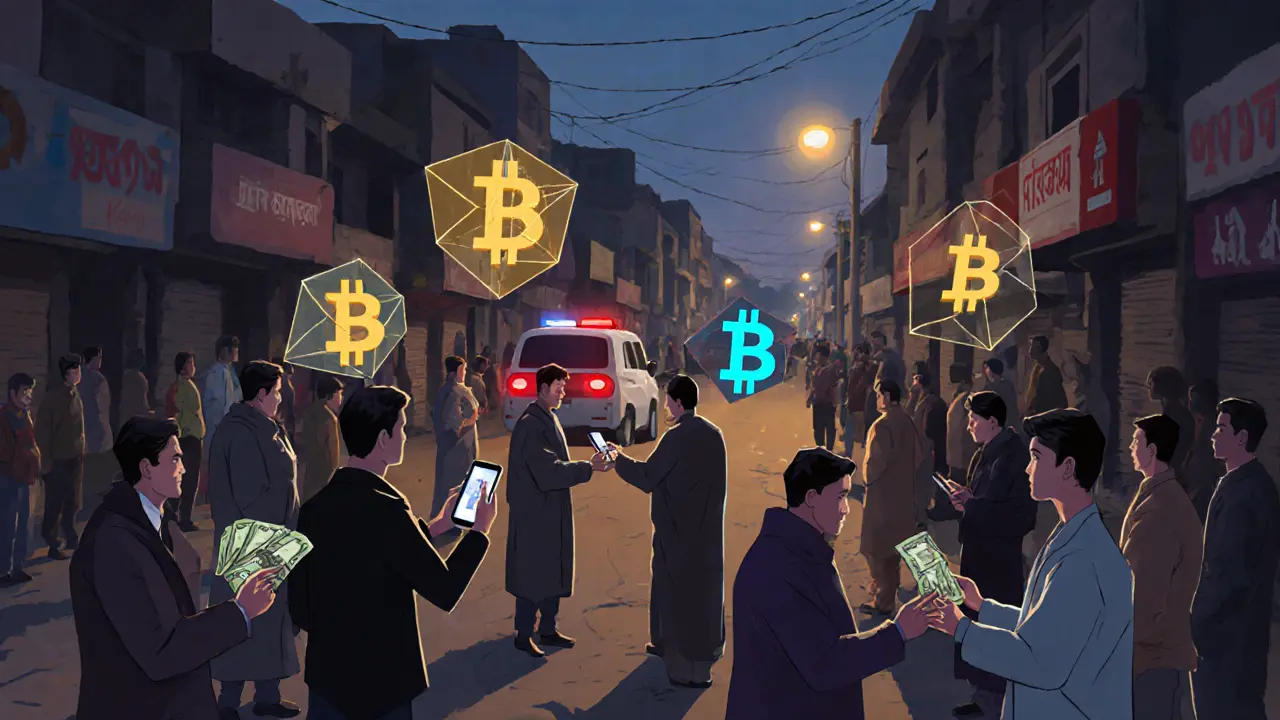Afghanistan Crypto Impact Estimator
Human Impact Calculator
Based on article data: $962 million in crypto transactions (July 2020-June 2021) and 97% poverty rate.
Estimated Impact
Based on data from the article and UNICEF reports
When the Taliban took control of Afghanistan in August 2021, the country’s banking system collapsed. International sanctions froze billions in assets. Banks closed. ATMs ran dry. For millions of Afghans, there was no way to pay for food, medicine, or send money to family abroad. That’s when cryptocurrency became a lifeline.
Bitcoin, USDT, and other digital currencies filled the void. People used peer-to-peer apps to trade crypto for cash on street corners. Families relied on remittances from relatives overseas sent via crypto wallets. Chainalysis reported that between July 2020 and June 2021, Afghanistan saw over $962 million in crypto transactions-ranking it 20th globally for grassroots adoption. In a country where 97% of people now live below the poverty line, crypto wasn’t a luxury. It was survival.
The Ban That Broke the Lifeline
In June 2022, the Taliban’s central bank issued a formal ban on cryptocurrency trading. The justification? Islamic law. Officials claimed digital currencies were a form of gambling and fraud-gharar, or excessive uncertainty-that violated religious principles. But the real reason was control. With international banks cut off, the Taliban couldn’t track or tax crypto flows. It was money outside their grasp.
The ban didn’t come with clear rules. Was it targeting all crypto? Or just foreign exchange platforms? The central bank’s spokesman told Bloomberg, “There is no instruction in Islamic law to approve it.” But for ordinary Afghans, the line between legal and illegal was invisible. One trader told Coinspeaker he’d been making 1-2% profit daily on USDT trades. After the ban, he couldn’t afford to feed his kids.
From Warnings to Prison Cells
At first, enforcement was light. Police shut down a few crypto exchange shops in Kabul and Herat. But by 2023, the crackdown turned violent. In August 2022, 13 people were arrested in Herat alone. More than 20 crypto businesses were closed. By May 2023, eight traders were locked up in Herat’s central prison for 28 days. Authorities threatened up to six months in jail for continuing to trade.
Herat became ground zero. As Afghanistan’s third-largest city and a key trade hub near Iran, it was a hotspot for cross-border crypto activity. In September 2023, police there shut down 16 exchanges and arrested staff members. Sayed Shah Sa’adat, head of Herat’s counter-crime unit, confirmed the raids were part of a nationwide campaign. “Digital currency trading has caused a lot of problems and is scamming people,” he said. But many of those arrested weren’t scammers-they were shopkeepers, students, and parents trying to keep their families alive.

Who Got Hit the Hardest?
The Taliban’s enforcement didn’t target terrorist financiers. It targeted the poor.
TRM Labs’ 2025 Crypto Crime Report noted that Islamic State Khurasan Province (ISKP) had used crypto for small transactions-some as low as $100-to fund attacks. But these cases were rare. Meanwhile, hundreds of ordinary citizens were jailed for sending $50 to a cousin in Turkey or receiving $200 from a brother in the U.S.
One man told CoinDesk his entire family survived on Bitcoin remittances from his brother in California. “There’s no other way,” he said. “If I stop trading, my children starve.”
Even humanitarian groups had turned to crypto. The Women’s Entrepreneurship Day Organization (WEDO) partnered with Opengrants.io to send weekly food payments in USDT to 100,000 Afghan women. When the ban hit, those payments stopped. UNICEF warned in 2023 that over a million Afghan children were at risk of severe malnutrition. Cutting off crypto didn’t stop poverty-it made it deadlier.
What Happens to the Crypto?
No one knows for sure.
Some detainees told Crypto.news their digital wallets were left untouched. Others reported their entire holdings-sometimes tens of thousands of dollars-were seized. There’s no public record of asset recovery, no legal process, no court hearings. The Taliban doesn’t publish its seizure logs. It just takes.
That uncertainty makes the risk even worse. People don’t know if they’re being arrested for trading… or for having too much crypto in their wallet. So many stopped using wallets entirely. Others moved to privacy coins like Monero or used offline P2P trades-risking scams, theft, or worse.

The Paradox of Control
The Taliban’s ban was supposed to bring order. Instead, it created chaos.
By banning crypto, they eliminated the only financial system that still worked. No banks. No wire transfers. No PayPal. No remittance companies. Crypto was the last bridge to the outside world. Now, that bridge is guarded by armed police.
And yet, crypto hasn’t disappeared. It’s gone underground. People trade in alleyways. They use encrypted apps. They meet in mosques or tea shops to swap cash for digital tokens. The volume has dropped-but not the need. The World Bank says 97% of Afghans live in poverty. That number hasn’t changed. The hunger hasn’t gone away. The only thing that changed is the punishment for trying to survive.
What’s Next?
There’s no sign the Taliban will reverse course. The regime sees crypto as a threat to its authority. And with no international recognition, no access to global finance, and no real economy to rebuild, the Taliban has little incentive to let people use tools that bypass its control.
But the people aren’t giving up. A growing number are using decentralized tools-like blockchain-based remittance platforms and offline wallet backups-to keep sending money. Some are learning to mine crypto on solar-powered rigs. Others are teaching neighbors how to use QR codes to receive payments without internet.
The crackdown may be brutal. But in Afghanistan, survival has always meant finding ways around the rules. Crypto didn’t cause this crisis. It was the only tool left to fight it. And as long as the banks stay closed and the hunger stays real, people will keep finding ways to trade-even if it means risking prison.

Jason Coe
November 1, 2025 AT 21:47Man, this hits different. I grew up in a country where you could just wire money anywhere, but here? People are literally trading Bitcoin for bread on street corners. It’s not about speculation-it’s about keeping kids alive. The Taliban’s ban isn’t about religion, it’s about power. They can’t control what they can’t track, so they crush it. And the worst part? The people getting arrested aren’t drug lords or terrorists-they’re moms sending $50 to a cousin in Turkey so her baby doesn’t starve.
Chainalysis data shows Afghanistan was top 20 globally for crypto adoption, and that’s not because people are into ‘decentralized finance.’ It’s because the banking system collapsed and the world walked away. Now the Taliban’s trying to force people back into a vacuum. That’s not governance. That’s cruelty dressed up as doctrine.
Brett Benton
November 1, 2025 AT 21:50Let me just say this: crypto saved lives in Afghanistan. Not because it’s perfect, not because it’s some futuristic utopia-but because it was the only thing that worked when everything else burned down. I’ve seen refugees in Jordan using USDT to get food vouchers. I’ve talked to guys in Pakistan who send crypto to sisters in Kabul because Western Union won’t touch them.
The Taliban’s excuse? ‘Gharar.’ Bullshit. They banned it because they can’t tax it, control it, or steal it easily. And now? Families are starving because the only bridge to the outside world got blown up by armed men in turbans. This isn’t about Islam. It’s about tyranny.
David Roberts
November 2, 2025 AT 03:59Actually, the narrative here is oversimplified. Crypto adoption in Afghanistan was never grassroots-it was opportunistic, fueled by diaspora remittances and shadow economies. The real issue is liquidity fragmentation. When the central bank collapsed, crypto filled the arbitrage gap, not the humanitarian one. TRM Labs’ report does show ISKP used crypto, but the scale is negligible compared to the volume of survival transactions.
What’s being ignored is the lack of KYC infrastructure. Without identity verification, any system becomes a vector for illicit flows. The Taliban’s crackdown, however brutal, isn’t irrational-it’s a failed attempt at monetary sovereignty in a post-sanctions state. The problem isn’t crypto. It’s the absence of any functional financial architecture.
Monty Tran
November 4, 2025 AT 01:17The Taliban banned crypto because it threatens their authority. End of story. No need for flowery language. No need for moralizing. They are fascists. They don’t care about Islamic law. They care about control. People trading USDT aren’t gamblers-they’re parents. The fact that you need a PhD in blockchain to understand why this is wrong says everything about how broken the world is. They lock people up for sending $200 to family. That’s not justice. That’s evil.
Beth Devine
November 4, 2025 AT 05:30I know this sounds harsh, but hear me out: the people who are getting arrested aren’t criminals-they’re heroes. They’re the ones who figured out how to keep their families alive when the world abandoned them. I’ve worked with NGOs in conflict zones, and I’ve never seen anything like this. Crypto wasn’t a choice-it was the last tool left. The Taliban didn’t ban crime. They banned survival.
Let’s not forget: WEDO’s USDT payments fed 100,000 women. That’s not speculation. That’s aid. And now it’s gone. We need to stop framing this as a crypto issue. It’s a human rights emergency.
Brian McElfresh
November 4, 2025 AT 23:46Wait. This whole thing is a psyop. Crypto bans in Afghanistan? Totally staged. The US and Israel are using this to discredit the Taliban so they can justify more sanctions. The ‘arrests’? Probably actors. The ‘remittances’? Fake blockchain addresses funded by dark web ops. You think the Taliban is dumb enough to let people use crypto? They’re the ones running the exchanges behind the scenes. They just want you to think they’re banning it so the West feels guilty for not helping. It’s all theater. Look at the timing-right after the UN report. Coincidence? I think not.
Jessica Hulst
November 6, 2025 AT 12:48It’s funny how we romanticize resistance while ignoring the systems that make resistance necessary. Crypto didn’t ‘save’ Afghanistan-it exposed how broken the global financial order is. The West froze billions in assets, cut off remittance channels, and then watched as people turned to Bitcoin. And now we act shocked when the Taliban cracks down? We built the vacuum.
The Taliban’s ban is monstrous, yes. But it’s not an anomaly. It’s a symptom. We created a world where a mother in Herat has to risk prison to feed her child because no one in Geneva or Washington cared enough to build a real safety net. Crypto was never the villain. We were.
Kaela Coren
November 7, 2025 AT 02:27The empirical data presented in this article is compelling and aligns with macroeconomic observations from the region. The collapse of formal financial infrastructure post-August 2021 created a de facto monetary vacuum. Cryptocurrencies, particularly stablecoins, served as a non-sovereign medium of exchange with low transaction costs and high liquidity in peer-to-peer contexts.
However, the absence of regulatory clarity and the lack of legal recourse for seized assets present profound governance challenges. The Taliban’s enforcement actions, while morally indefensible, reflect a rational (if brutal) attempt to reassert fiscal sovereignty in the absence of international recognition. The humanitarian cost is undeniable, yet the structural issue remains: no state can function without a controlled monetary base.
Nabil ben Salah Nasri
November 7, 2025 AT 13:35Man, this just breaks my heart 😔 I’ve seen how hard it is for families to get money across borders even in normal times. In Afghanistan? They turned to crypto because they had NO OTHER CHOICE. And now they’re being jailed for it? That’s not justice. That’s a crime against humanity.
Shoutout to the women using USDT to feed their kids. You’re warriors. And to the Taliban? You’re not protecting Islam-you’re destroying it. The Prophet (PBUH) said ‘Help the oppressed, even if it’s with your voice.’ What are you doing? Locking up the poor? That’s not faith. That’s fear.
Let people send money. Let them live. Please. 🙏
alvin Bachtiar
November 8, 2025 AT 05:42This is peak capitalist irony. The same Western institutions that weaponized sanctions to strangle Afghanistan’s economy now cry foul when people use crypto to bypass them. The Taliban’s crackdown isn’t about religion-it’s about the failure of neoliberal financial hegemony. You froze their reserves, cut off SWIFT, and then acted surprised when people found a decentralized workaround?
Let me be clear: crypto didn’t create this crisis. Sanctions did. The World Bank says 97% of Afghans live in poverty? That’s not a statistic-it’s a war crime. And the people getting arrested? They’re the collateral damage of a system that values control over compassion.
DeeDee Kallam
November 9, 2025 AT 14:16Why do people always act like the Taliban are the only bad guys? What about the US? They stole billions and left people to starve. And now we’re crying about crypto? Ugh. I’m so tired. My dog died last week and I’m still more upset than I am about this. Like… can we just move on? Nobody cares anymore anyway.
Helen Hardman
November 10, 2025 AT 00:16I just want to say: if you’ve ever sent money to a family member across borders, imagine if you couldn’t. No apps. No banks. No options. That’s what life became for millions in Afghanistan. Crypto wasn’t a trend-it was oxygen.
I work with refugees, and I’ve seen women cry because they couldn’t send $30 to their sister in Kabul. That’s not ‘speculation.’ That’s love. That’s survival.
And now? The Taliban locks them up. I don’t care what their excuse is. This isn’t about religion. It’s about power. And it’s heartbreaking. But I’m still so proud of the people who kept going. Who kept trading. Who kept feeding their kids. You’re the real heroes. Keep going. We see you. ❤️
Bhavna Suri
November 10, 2025 AT 21:35This article is too long. Taliban banned crypto. People got arrested. End. No need for so many words. Simple things are better.
Elizabeth Melendez
November 12, 2025 AT 07:43I’ve been following this since 2021 and I still get teary-eyed thinking about it. One mom in Herat told a reporter she traded USDT for flour every Tuesday. That’s it. Just flour. No fancy tech, no crypto bros-just a woman trying to make sure her kids didn’t go to bed hungry.
And then the police came. Took her phone. Locked her up. Said she broke the law.
What law? The one that says you can’t feed your child? That’s not a law. That’s a nightmare.
I don’t know how to fix this. But I know we can’t look away. We owe it to them to keep talking. To keep sharing. To keep saying: this is wrong. Please. Just say it’s wrong.
Phil Higgins
November 13, 2025 AT 19:38Let’s not pretend this is about ideology. It’s about control. The Taliban didn’t ban crypto because it violates Sharia-they banned it because it undermines their monopoly on economic power. When people can transact outside state supervision, authority becomes porous. That’s existential for any authoritarian regime.
And yet, the most tragic irony is this: the very people who suffer most under this ban are the ones who need the system least. They aren’t seeking profit. They’re seeking survival. The Taliban doesn’t care. They see wallets, not people. And that’s the real crime.
Genevieve Rachal
November 14, 2025 AT 13:10Let’s be real-this is a humanitarian disaster wrapped in crypto hype. People are dying. But let’s not romanticize this as some noble resistance. Crypto is volatile. It’s unregulated. It’s full of scams. The fact that people are using it to survive says nothing about its virtue-it says everything about how broken the system is.
And the Taliban? They’re monsters. But they’re not the only ones. The West created this mess with sanctions. NGOs failed to build alternatives. The UN sat on its hands. Now we’re all playing moral outrage bingo while children starve. So yes, the ban is evil. But the entire global response? Also evil.
Eli PINEDA
November 14, 2025 AT 17:30so like… if someone sends u usdt and u cash it out… is that illegal? or just the exchange shops? i’m confused. like… is my cousin in afghanistan gonna get arrested if i send him 50 bucks? this is wild.